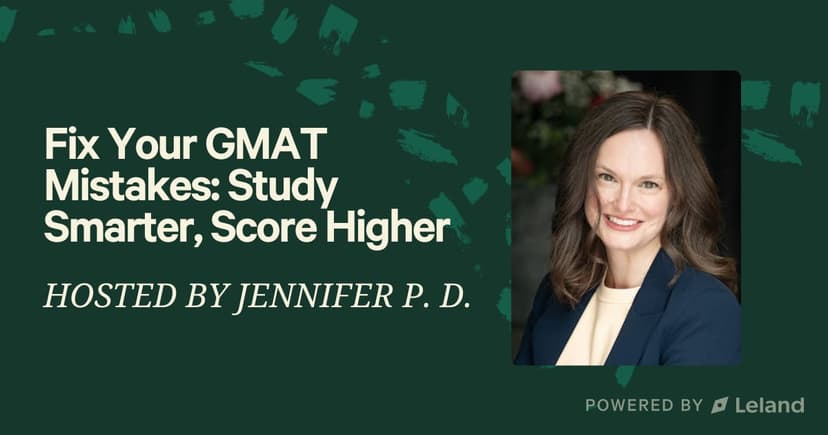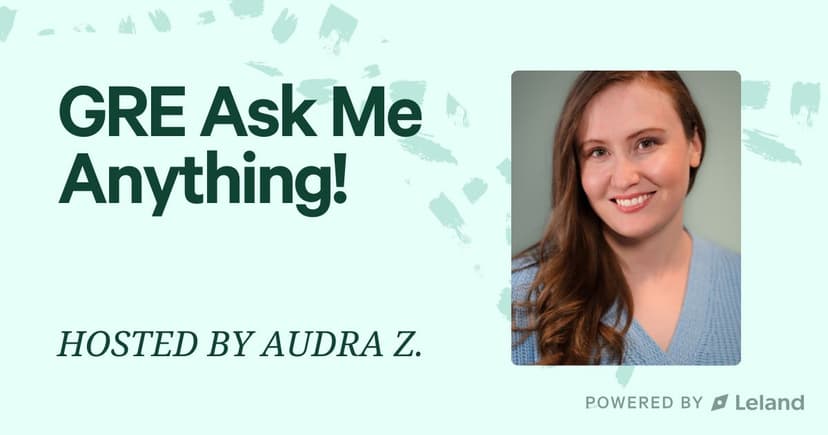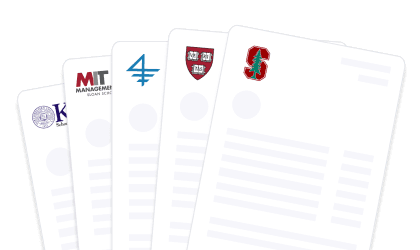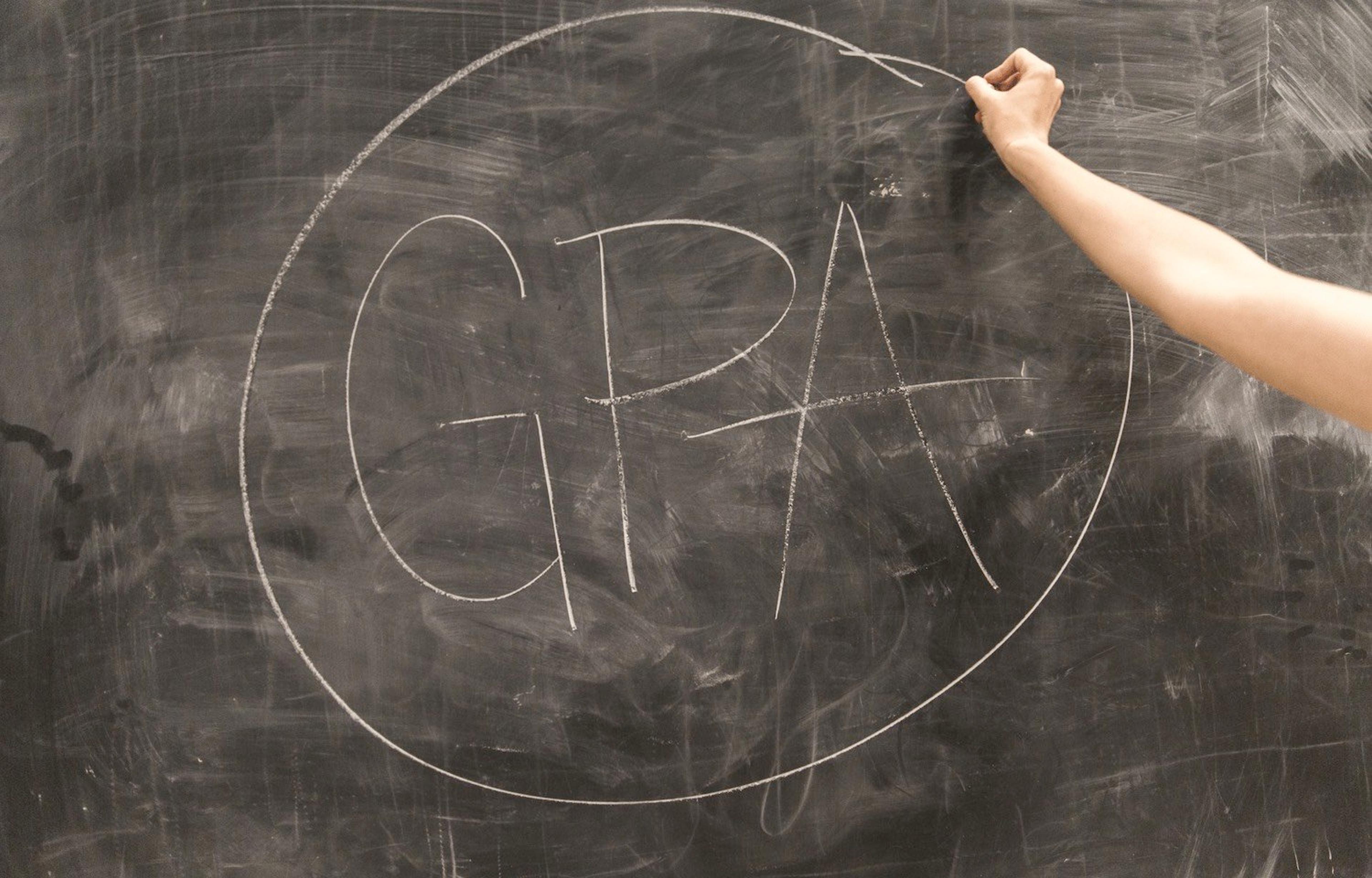GMAT Study Tips From Pro Tutors: From 600 to 700+
An expert GMAT/GRE coach with a Wharton MBA and 10+ years helping candidates land 325+ / 730+ scores outlines two of his top techniques to help you nail your study sessions.

By Bruce H.
Posted July 25, 2025

Join a free event
Learn from top coaches and industry experts in live, interactive sessions you can join for free.
Table of Contents
I’ve been coaching the GMAT and GRE for 10 years – both as a test prep instructor at UCLA and as the Founder of First Choice Admissions. I’m also a test prep coach in Leland. I’ve helped literally hundreds of students ace these tests and most of them are busy professionals who need to make the most out of every hour they can squeeze into studying.
These are the two most effective techniques I’ve used to significantly boost my students’ efficiency and productivity when they study.
What’s the most effective way to study for the GMAT or GRE?
Two of the most efficient study strategies are: (1) redoing every missed quant question three times to deeply learn patterns, and (2) studying 5–6 days a week to strengthen neural connections and build long-term retention. These techniques help you improve faster in less time.
Read: How to Study for GMAT: The GMAT Tutor's Guide
Technique 1: Redo Every Missed Quant Question Three Times
This is THE quickest way I know to climb the learning curve and I’ve seen it work time and again. It makes perfect sense when you think about it. Repeating a missed question three times helps you identify your blind spots, internalize the solution process, and recognize recurring test patterns, which is exactly how top scorers train.
Why It Works
Most people do a problem once and move on, but if you got it wrong, that first pass only tells you what you don’t know. The second attempt lets you rebuild your understanding and test whether your fix works.
By the third time, you're getting the question right and you’re also recognizing the deeper pattern and learning to spot it in new problems. The GMAT and GRE are repetitive by design. Spot the pattern once, and you’ll be faster next time, on a totally different question.
How to Apply It (Step-by-Step)
Step 1: First Retry (Right After Review)
- Attempt the question again shortly after reviewing the solution.
- Focus on doing it without looking at the explanation.
- Identify where your process failed and why; was it a misread, a conceptual gap, or a calculation slip?
Step 2: Second Retry (Later That Day or Next Day)
- Redo the problem cold, no notes or solution in front of you.
- This time, talk through your logic out loud or write it step-by-step to reinforce clarity.
- Aim to solve it fluidly, but watch carefully for any hesitation, those moments reveal partial understanding.
Step 3: Final Retry (48–72 Hours Later)
- Come back again, still from scratch.
- Ask: Can I recognize the setup, identify the “trick,” and execute confidently?
- Bonus: explain to a friend or your future self (in notes) what to watch for next time this pattern appears.
Pro Tip: Create a “Pattern Tracker”, like a running list of question types and tricks (e.g., hidden ratios, disguised averages, smart estimation). Over time, you’ll see how often those patterns repeat, and how much faster you get.
Technique 2: Study Multiple Days in a Row
Don’t let the neural path grow over!
You have a ‘gardener’ inside your brain. It’s okay, we all do. The Gardener’s job is to figure out which neural connections are important, the connections that you need to keep and strengthen, and which are less important and can grow weaker over time. While you sleep, the Gardener comes out and essentially ‘clears out the weeds’ from certain neural connections so they can bind together and get stronger and faster.
The Gardener can’t keep every single neural connection clear, though. So how does the gardener figure out which ones to maintain? Generally, the more recently you’ve used a connection, the higher priority that connection gets on the gardener’s list. If you do a little math or a little reading comp each day, those neural connections will get maintained at night and get stronger and faster when you wake up in the morning. Or as neurologists say (apparently neurologists have sayings), “the neurons that fire together wire together.” So, fire those neurons as much as you can!
This also explains why if you’ve ever tried to learn how to do anything (from playing piano, swinging a golf club or learning Spanish), practicing four hours all at once on the weekend is much less effective than practicing a little bit every day. The same is true for the GMAT and GRE. Practicing every day (or 5 – 6 days a week) is much more effective than doing marathon sessions once or twice a week. If you do something only once a week the neural connection gets ‘weedy’ and slower between practice sessions. But if you practice each day those neural connections are growing stronger and faster and each time you practice you get more and more efficient.
Also, it’s important to note that the GMAT/GRE works just like anything else in life ... the more you practice, the better you get. Keep practicing a little bit every day and you’ll keep getting better.
Common Mistakes Students Make with GMAT/GRE Prep
Even the most motivated test-takers can fall into habits that slow their progress. Here are three of the most common prep mistakes and how to avoid them:
Only Studying Once or Twice a Week
Studying for four hours once a week feels productive, but it’s far less effective than shorter, consistent sessions. Your brain needs regular reinforcement to retain concepts and sharpen skills. When you go too long between sessions, you’re essentially starting over each time.
Do this instead: Study 5–6 days a week, even if only for 30–45 minutes. This keeps your neural pathways “clean” and builds lasting improvement.
Not Reviewing Missed Questions
Doing a full set of practice questions without reviewing your mistakes is like lifting weights without checking your form. You’ll repeat the same errors and wonder why you’re not improving.
Do this instead: Every missed question should be reviewed, redone (3x if quant), and logged. Understand not just what the right answer is, but why your approach didn’t work.
Overvaluing Volume Over Precision
Cramming hundreds of questions might feel like progress, but without reflection and review, it’s just repetition.
Do this instead: Prioritize quality over quantity. It’s better to fully master 20 questions than speed through 100. Focus on pattern recognition and skill-building, not just “getting through the material.”
GMAT Preparation Tips
When it comes to crushing the GMAT exam, success is about building a smart, repeatable learning process that mirrors the actual test. Whether you’re using a course or going the self study route, these tactical tips will help you optimize every hour of prep and show up on test day ready to perform.
1. Treat Practice Tests Like Dress Rehearsals
Your practice tests should replicate test-day conditions as closely as possible. That means timing everything, using only official scratch paper, and even simulating the break schedule.
Why?
Because the biggest challenge on test day is managing your mental energy over several hours. Use these tests to refine your time management and build stamina.
Schedule your practice tests at the same time as your actual exam slot, especially if you’re not a morning person but have an 8 a.m. time at your testing center.
2. Build a Study Plan Around Your Weakest Areas
Don’t just “study everything”, but be surgical. If you’re struggling with data sufficiency questions in the quant sections, build your study plan around tackling those specifically. Your study schedule should focus on patterns in your mistakes, not just clocking hours.
Review every missed question three times; once to understand, once to correct, once to spot the pattern (see Technique 1). That’s how real progress happens.
3. Start Preparing With a Diagnostic Baseline
Before you dive into a full prep plan, take a diagnostic test. Your first practice test isn’t about scoring high, it’s about revealing what content you’ve retained and where your gaps are. From there, build a study schedule that rotates between targeted drills, review sessions, and full-length simulations.
Don't skip verbal. Many quant-focused students neglect it and leave points on the table, especially in Critical Reasoning and Sentence Correction.
Read:
4. Prioritize Review Just as Much as Practice
Doing 100 questions isn’t helpful if you don’t learn from them. After every study session, spend time breaking down what you missed, why it happened, what misled you, and what you’ll do differently next time. That’s the real learning process, and not just repetition, but reflection.
5. Use Your Final Weeks to Sharpen Strategy, Not Cram
In the final 2–3 weeks before your GMAT exam, stop learning new content and focus on execution. This is the time to refine pacing, solidify strategy for tough question types, and build the confidence you’ll need at the testing center.
Take at least 2–3 days completely off before the exam. You want to walk into test day mentally fresh, and not fried from last-minute cramming.
Read: Top 50+ Free Resources for GMAT & GRE Practice
Final Advice + How to Work With a Coach
Final Advice: Small Changes = Big Results
The GMAT and GRE are about strategy, consistency, and mindset. Most students don’t need more hours; they need better ones. Redoing missed questions and studying consistently, even just 30 focused minutes a day can lead to real score jumps over time.
So if you’re feeling stuck, remember: the key isn’t to study harder. It’s to study smarter.
Why Work With a Coach
Bruce H. is a Wharton MBA and professional test prep coach. He is a former Curriculum Development and Test Prep Instructor at UCLA and has more than ten years of experience helping hundreds of students reach their target scores. Book a FREE intro call with Bruce today!
Read these articles next:
- GMAT vs. GRE for Business School—Which Should You Take (and How to Ace Both)
- Top 50+ Free Resources for GMAT & GRE Practice
- The 10 Best GMAT Tutors
FAQs
How long will it take to prepare for the GMAT?
- Most test-takers need 2 to 3 months of focused prep, typically around 100–120 hours total. That includes learning content, reviewing answer explanations, and taking full-length practice exams to simulate the real test environment.
What is the best way to prep for the GMAT?
- Start with a diagnostic to find your baseline, then build a custom study plan focused on your weaknesses. Mix targeted drills with timed practice exams, and always review answer explanations to understand the logic behind each question. Near the end, simulate the actual exam using official test-day conditions.
Is scoring 700 in GMAT tough?
- Yes, but it’s achievable with the right prep. A 700+ score puts you in the top 10% of test-takers and requires strong execution across all sections. The key is consistency, pattern recognition, and smart review of practice exams.
Is 650 a bad GMAT score?
- Not at all. A 650 is above average and competitive for many MBA programs, especially if paired with a strong profile. That said, if you're aiming for top-10 schools, you may want to push higher with more focused review and better performance on the actual exam.
Is 450 a bad GMAT score?
- A 450 is below average and may limit your options at competitive programs. However, it’s a starting point, not a dead end. With structured prep, consistent review of answer explanations, and regular practice exams, many test-takers improve by 100+ points.

Written by Bruce
5.0
(34)
I've been coaching the GRE, GMAT, ACT and SAT for 12 years - both as the founder of First Choice Admissions and at UCLA. I specialize in getting clients top scores and getting them into top schools. I am the head instructor for Leland's GRE and GMAT bootcamps. Leland uses my propriety curriculum for their bootcamps and I create the materials to train other GRE and GMAT instructors. I trained as a teacher at Grinnell College and graduated with my high school teaching certificate. So naturally after college I became a professional musician. Yeah, my folks had the same reaction. So while my band racked up some college radio hits and I got to tour the country playing music, it became pretty clear that spending the rest of my life with four sweaty guys in a touring van was an idea that only looked good on paper. I needed to make a change. So I taught myself how to do really, really well on the GMAT so that business schools would take me seriously (did I mention the professional musician part?). I was accepted to Wharton and two years later I started a pretty conventional post MBA career. I worked as a marketer for General Mills, did strategy and financial consulting in Silicon Valley and I helped my friends launch (sometimes) successful start-ups. I was also was the founding partner in a company that ran live music venues in San Francisco and Oakland. And while all of those ventures were fun (and some even lucrative) my passion had always been teaching. So started a test prep company, First Choice Admissions, in a garage in Palo Alto (cliche I know) and began tutoring the GMAT, GRE, ACT and SAT. After a couple of years I move down to LA (I'd like to say it was for savvy business reasons - but really it was for a girl). Soon after I moved, UCLA hired me to develop test prep curriculum and teach the GMAT, GRE, ACT and SAT. After working with them for several years, I turned my attention full-time to First Choice Admissions. I've been running First Choice for the last 10 years and everyday I love coaching these tests and helping my clients get into their dream schools.
Bruce has helped clients get into organizations like:
Browse hundreds of expert coaches
Leland coaches have helped thousands of people achieve their goals. A dedicated mentor can make all the difference.

























